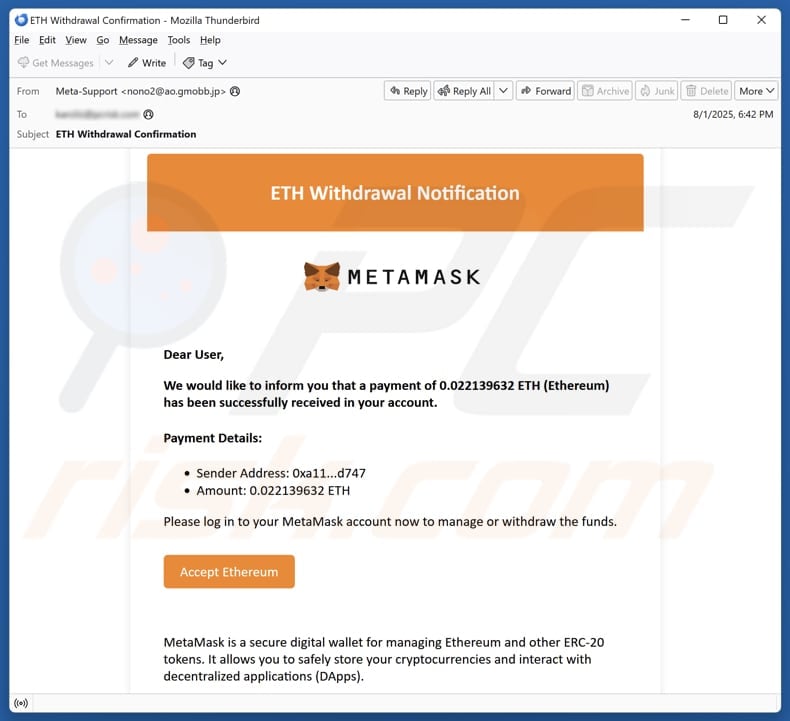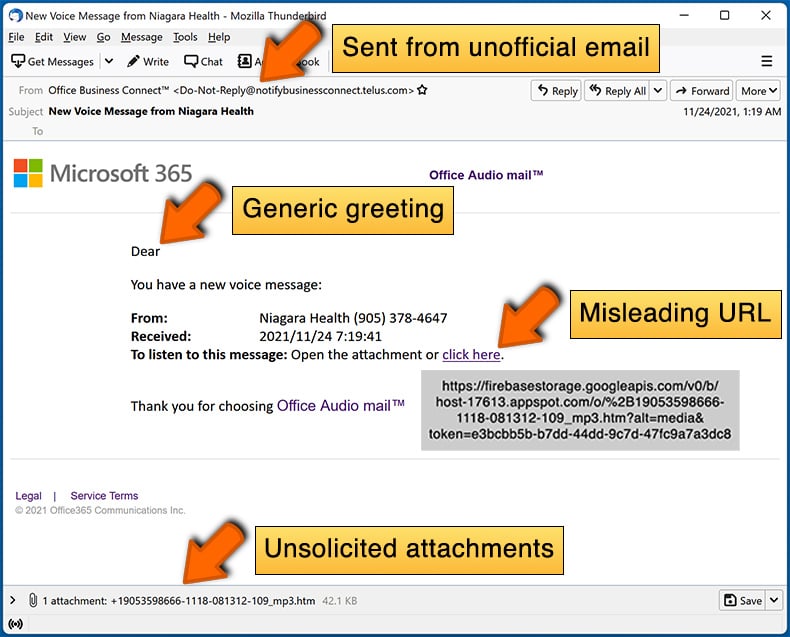How to spot scams like "Metamask - ETH Withdrawal Notification"
Phishing/ScamAlso Known As: Fake Metamask - ETH Withdrawal Notification
Get free scan and check if your device is infected.
Remove it nowTo use full-featured product, you have to purchase a license for Combo Cleaner. Seven days free trial available. Combo Cleaner is owned and operated by RCS LT, the parent company of PCRisk.com.
What kind of scam is "Metamask - ETH Withdrawal Notification"?
We have inspected the email and concluded that it is a fake "ETH Withdrawal Notification" containing a link to a phishing website. The purpose of this scam email is to extract personal information from recipients. Falling for it can lead to financial loss and possibly other issues.

More about the "Metamask - ETH Withdrawal Notification" scam email
The scam email is designed to appear as an official Ethereum withdrawal confirmation from MetaMask. It claims that the recipient has received a payment of 0.022139632 ETH from the specified wallet address. The message encourages the recipient to log in to their MetaMask account to manage or withdraw the funds.
It contains a link labeled "Accept Ethereum". It is likely that this link was intended to open a fake MetaMask site (during our examination, the page was not accessible). Usually, such sites are designed to steal login credentials. In this case, the stolen details could be used to access and drain wallets.
It is worth noting that scammers behind such emails also often try to steal email account credentials. By gaining access to an email account, fraudsters can reset passwords for connected services, read emails, and potentially use the compromised account to launch phishing attacks or distribute malware.
Overall, falling for these scams can lead to financial loss, identity theft, account hijacking, and other problems.
| Name | Metamask - ETH Withdrawal Notification Email Scam |
| Threat Type | Phishing, Scam, Social Engineering, Fraud |
| Fake Claim | The recipient has received a payment of 0.022139632 ETH |
| Disguise | Ethereum withdrawal confirmation from MetaMask |
| Symptoms | Unauthorized online purchases, changed online account passwords, identity theft, illegal access of the computer. |
| Distribution methods | Deceptive emails, rogue online pop-up ads, search engine poisoning techniques, misspelled domains. |
| Damage | Loss of sensitive private information, monetary loss, identity theft. |
| Malware Removal (Windows) |
To eliminate possible malware infections, scan your computer with legitimate antivirus software. Our security researchers recommend using Combo Cleaner. Download Combo CleanerTo use full-featured product, you have to purchase a license for Combo Cleaner. 7 days free trial available. Combo Cleaner is owned and operated by RCS LT, the parent company of PCRisk.com. |
Similar scam emails in general
These emails are crafted to mimic legitimate notifications. They often impersonate trusted services to trick users into visiting fraudulent websites and submitting sensitive information. The consequences of falling for such schemes can include financial loss, unauthorized access to cryptocurrency wallets, email account compromise, and further exploitation.
Examples of similar scams are "Account Validation Request", "DocuSign Electronic Signature Request", and "Cloud Storage Alert".
How do spam campaigns infect computers?
One of the methods cybercriminals use to spread malware via email is by including malicious attachments. These attachments can come in various forms, including Word or Excel documents, PDFs, executable files (.exe), scripts, or archives like ZIP and RAR. Malware can be executed after opening a malicious file.
Another technique involves sending malicious links. When clicked, these links may lead to websites that automatically download malware onto the system or deceive users into downloading and executing it themselves.
How to avoid installation of malware?
Download programs and files from official websites or verified app stores. Avoid using pirated software, cracking tools, or unauthorized activation tools. Make sure your operating system and software are regularly updated, and protect your device with trusted antivirus solutions.
Be cautious when dealing with emails, especially those with unexpected attachments or suspicious links. Never interact with content from unknown or untrustworthy senders. Additionally, avoid clicking on pop-ups, ads, or buttons on dubious websites, and never grant notification permissions to shady pages.
If you have already opened malicious attachments, we recommend running a scan with Combo Cleaner Antivirus for Windows to automatically eliminate infiltrated malware.
Text presented in the "Metamask - ETH Withdrawal Notification" email letter:
Subject: ETH Withdrawal Confirmation
ETH Withdrawal Notification
Dear User,
We would like to inform you that a payment of 0.022139632 ETH (Ethereum) has been successfully received in your account.
Payment Details:Sender Address: 0xa11...d747
Amount: 0.022139632 ETHPlease log in to your MetaMask account now to manage or withdraw the funds.
Accept Ethereum
MetaMask is a secure digital wallet for managing Ethereum and other ERC-20 tokens. It allows you to safely store your cryptocurrencies and interact with decentralized applications (DApps).
If you have any questions, please visit our official support page.
Beste Grüße.
Sincerely,
MetamaskIhr MetaMask-Support-Team.
Instant automatic malware removal:
Manual threat removal might be a lengthy and complicated process that requires advanced IT skills. Combo Cleaner is a professional automatic malware removal tool that is recommended to get rid of malware. Download it by clicking the button below:
DOWNLOAD Combo CleanerBy downloading any software listed on this website you agree to our Privacy Policy and Terms of Use. To use full-featured product, you have to purchase a license for Combo Cleaner. 7 days free trial available. Combo Cleaner is owned and operated by RCS LT, the parent company of PCRisk.com.
Quick menu:
- What is Fake Metamask - ETH Withdrawal Notification?
- Types of malicious emails.
- How to spot a malicious email?
- What to do if you fell for an email scam?
Types of malicious emails:
![]() Phishing Emails
Phishing Emails
Most commonly, cybercriminals use deceptive emails to trick Internet users into giving away their sensitive private information, for example, login information for various online services, email accounts, or online banking information.
Such attacks are called phishing. In a phishing attack, cybercriminals usually send an email message with some popular service logo (for example, Microsoft, DHL, Amazon, Netflix), create urgency (wrong shipping address, expired password, etc.), and place a link which they hope their potential victims will click on.
After clicking the link presented in such email message, victims are redirected to a fake website that looks identical or extremely similar to the original one. Victims are then asked to enter their password, credit card details, or some other information that gets stolen by cybercriminals.
![]() Emails with Malicious Attachments
Emails with Malicious Attachments
Another popular attack vector is email spam with malicious attachments that infect users' computers with malware. Malicious attachments usually carry trojans that are capable of stealing passwords, banking information, and other sensitive information.
In such attacks, cybercriminals' main goal is to trick their potential victims into opening an infected email attachment. To achieve this goal, email messages usually talk about recently received invoices, faxes, or voice messages.
If a potential victim falls for the lure and opens the attachment, their computers get infected, and cybercriminals can collect a lot of sensitive information.
While it's a more complicated method to steal personal information (spam filters and antivirus programs usually detect such attempts), if successful, cybercriminals can get a much wider array of data and can collect information for a long period of time.
![]() Sextortion Emails
Sextortion Emails
This is a type of phishing. In this case, users receive an email claiming that a cybercriminal could access the webcam of the potential victim and has a video recording of one's masturbation.
To get rid of the video, victims are asked to pay a ransom (usually using Bitcoin or another cryptocurrency). Nevertheless, all of these claims are false - users who receive such emails should ignore and delete them.
How to spot a malicious email?
While cyber criminals try to make their lure emails look trustworthy, here are some things that you should look for when trying to spot a phishing email:
- Check the sender's ("from") email address: Hover your mouse over the "from" address and check if it's legitimate. For example, if you received an email from Microsoft, be sure to check if the email address is @microsoft.com and not something suspicious like @m1crosoft.com, @microsfot.com, @account-security-noreply.com, etc.
- Check for generic greetings: If the greeting in the email is "Dear user", "Dear @youremail.com", "Dear valued customer", this should raise suspiciousness. Most commonly, companies call you by your name. Lack of this information could signal a phishing attempt.
- Check the links in the email: Hover your mouse over the link presented in the email, if the link that appears seems suspicious, don't click it. For example, if you received an email from Microsoft and the link in the email shows that it will go to firebasestorage.googleapis.com/v0... you shouldn't trust it. It's best not to click any links in the emails but to visit the company website that sent you the email in the first place.
- Don't blindly trust email attachments: Most commonly, legitimate companies will ask you to log in to their website and to view any documents there; if you received an email with an attachment, it's a good idea to scan it with an antivirus application. Infected email attachments are a common attack vector used by cybercriminals.
To minimise the risk of opening phishing and malicious emails we recommend using Combo Cleaner Antivirus for Windows.
Example of a spam email:

What to do if you fell for an email scam?
- If you clicked on a link in a phishing email and entered your password - be sure to change your password as soon as possible. Usually, cybercriminals collect stolen credentials and then sell them to other groups that use them for malicious purposes. If you change your password in a timely manner, there's a chance that criminals won't have enough time to do any damage.
- If you entered your credit card information - contact your bank as soon as possible and explain the situation. There's a good chance that you will need to cancel your compromised credit card and get a new one.
- If you see any signs of identity theft - you should immediately contact the Federal Trade Commission. This institution will collect information about your situation and create a personal recovery plan.
- If you opened a malicious attachment - your computer is probably infected, you should scan it with a reputable antivirus application. For this purpose, we recommend using Combo Cleaner Antivirus for Windows.
- Help other Internet users - report phishing emails to Anti-Phishing Working Group, FBI’s Internet Crime Complaint Center, National Fraud Information Center and U.S. Department of Justice.
Frequently Asked Questions (FAQ)
Why did I receive this email?
Scammers sent the same generic message to all recipients. Usually, they do not target specific individuals and obtain email addresses from fake websites, data breaches, or other sources.
I have provided my personal information when tricked by this email, what should I do?
If you have shared account login details, update compromised passwords. If you have disclosed other sensitive information, such as credit card numbers or ID details, notify the appropriate institutions or authorities.
I have downloaded and opened a malicious file attached to an email, is my computer infected?
If the file was an executable, then it is very likely that your system is infected. However, if it was a document (such as a .pdf or .doc), you might have avoided malware, as simply opening such files is not always enough to trigger the infection.
I have read the email but did not open the attachment, is my computer infected?
Reading an email canot cause harm. Problems can occur when recipients engage with links or attachments inside the email.
Will Combo Cleaner remove malware infections that were present in email attachment?
Yes, Combo Cleaner is effective at identifying and eliminating most malware infections. Because sophisticated malware tends to conceal itself deeply, a thorough full system scan is necessary.
Share:

Tomas Meskauskas
Expert security researcher, professional malware analyst
I am passionate about computer security and technology. I have an experience of over 10 years working in various companies related to computer technical issue solving and Internet security. I have been working as an author and editor for pcrisk.com since 2010. Follow me on Twitter and LinkedIn to stay informed about the latest online security threats.
PCrisk security portal is brought by a company RCS LT.
Joined forces of security researchers help educate computer users about the latest online security threats. More information about the company RCS LT.
Our malware removal guides are free. However, if you want to support us you can send us a donation.
DonatePCrisk security portal is brought by a company RCS LT.
Joined forces of security researchers help educate computer users about the latest online security threats. More information about the company RCS LT.
Our malware removal guides are free. However, if you want to support us you can send us a donation.
Donate
▼ Show Discussion